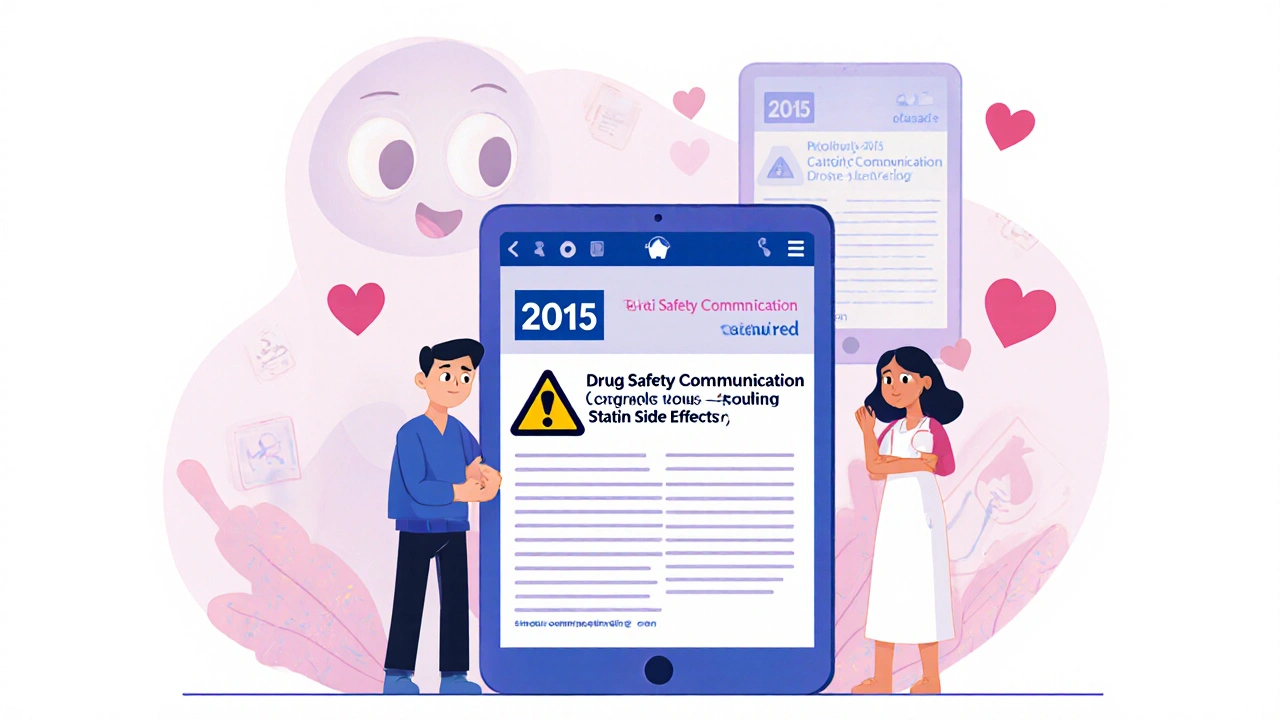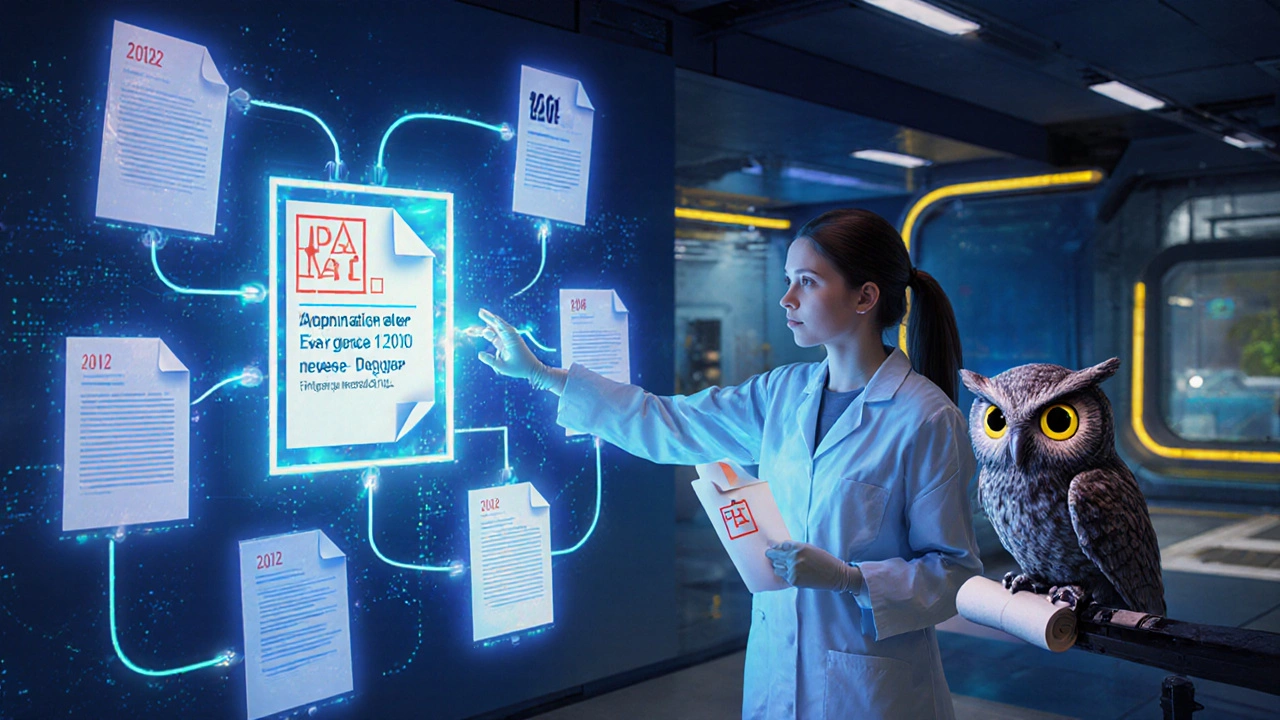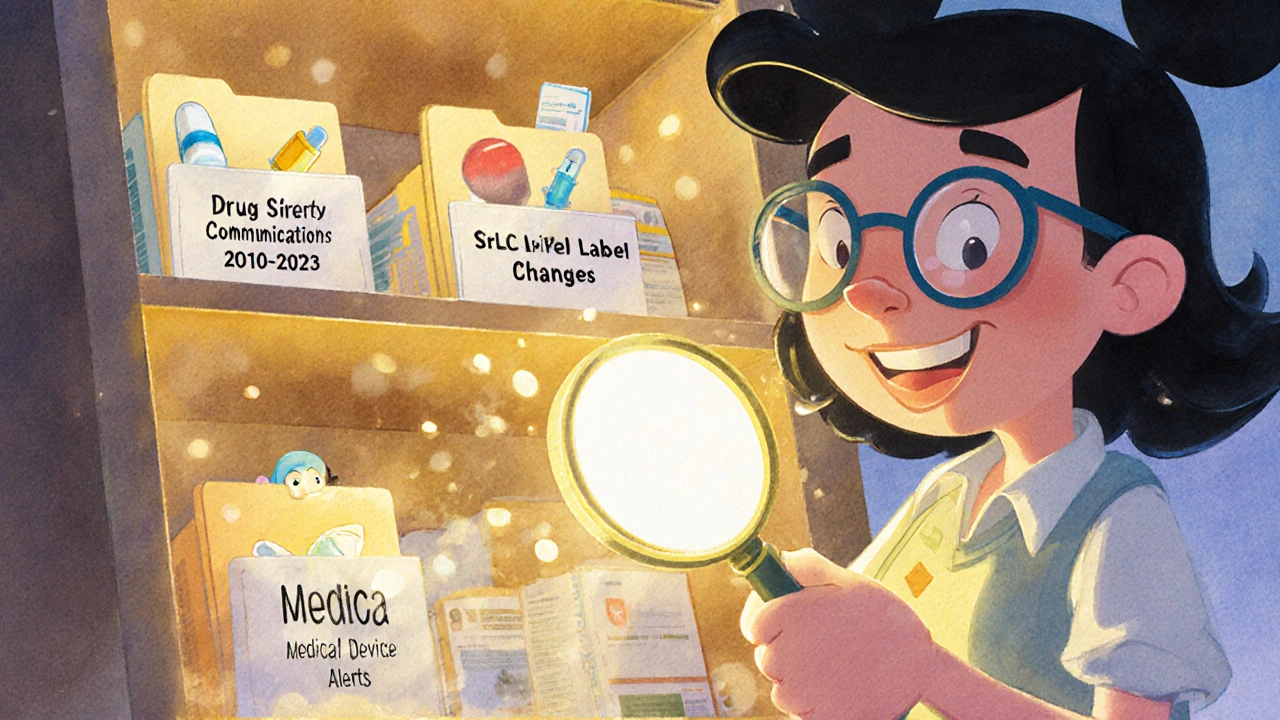FDA Safety Communications Timeline
Explore FDA Safety Communication History
Track how the FDA's safety alert systems evolved from 2010 to present, with key milestones for drug warnings, labeling changes, and medical device alerts.
First Drug Safety Communications launched. These public alerts warn about new safety issues found after a drug hits the market.
Drug Safety-related Labeling Changes (SrLC) database launched. Tracks exact changes to drug labels in official prescribing information.
Expanded Early Alerts program covers all medical devices, not just high-risk ones. Alerts now include actionable guidance for doctors and patients.
New tool announced to help researchers collect historical drug approval data. Improved search and cross-referencing between drug and device alerts.
Older DSCs are marked as archived when replaced by newer communications with updated information.
For historical warnings predating 2010, use the FDA's web archive to view old versions of their pages.
The U.S. Food and Drug Administration (FDA) doesn’t just issue warnings about unsafe drugs and devices - it keeps a public, searchable record of every one. If you’re trying to find out what the FDA said about a medication or medical device five, ten, or even fifteen years ago, you’re not stuck. The FDA Safety Communications Archive is your go-to resource. It’s free, it’s detailed, and it goes back over a decade with organized records you can actually use.
What’s in the FDA Safety Communications Archive?
The archive isn’t one big file. It’s three main systems working together: Drug Safety Communications (DSCs), Drug Safety-related Labeling Changes (SrLC), and Medical Device Safety Communications. Each tracks different types of risks, and each has its own rules for what’s included.Drug Safety Communications started in 2010. These are the FDA’s public alerts about new safety issues found after a drug hits the market. They might warn about liver damage from a diabetes pill, heart rhythm problems linked to an antibiotic, or rare but serious side effects in elderly patients. The FDA archives these by year - so you can pull up every DSC from 2012, 2017, or 2023. Older ones are marked as archived because newer communications replaced them with updated info.
Then there’s the SrLC Database. This one’s more technical. It tracks exact changes to drug labels - the fine print inside the prescribing information. Since January 2016, every time the FDA requires a manufacturer to update a warning in the BOXED WARNING, CONTRAINDICATIONS, or WARNINGS AND PRECAUTIONS sections, it’s added here. These aren’t just summaries. They’re the actual legal changes to the drug’s official labeling. If you need to know when a drug’s label first warned about kidney damage, this is where you look.
Medical Device Safety Communications work differently. These alerts cover everything from faulty pacemakers to contaminated surgical tools. Since September 29, 2025, the FDA expanded its Early Alerts program to cover all medical devices - not just high-risk ones. That means even a simple blood pressure cuff with a faulty sensor could trigger a public alert. These alerts include not just the problem, but what doctors and patients should do about it.
How to Find What You Need
You don’t need special access or a login. Everything is on the FDA’s website. Start at the Drug Safety and Availability page. From there, click on “Drug Safety Communications” to see the yearly archives. Each year has a downloadable list with titles, dates, and links to the full alert.If you’re looking for labeling changes since 2016, go to the SrLC Database. You can search by drug name, active ingredient, or even by the section of the label that changed. Want to know when metformin got a new warning about vitamin B12 deficiency? Search for “metformin” and filter by “Adverse Reactions.”
For medical devices, head to the Medical Device Safety Communications page. You can filter by device type - implants, diagnostic tools, home-use equipment - and sort by date. The Early Alerts are flagged clearly, so you know which ones are urgent.
What if you need something older than 2010? The FDA’s web archive lets you view old versions of their pages. Type in the URL of the current Drug Safety page, then use the Wayback Machine link on the FDA site to browse snapshots from 2008, 2009, or even 2005. For paper records going back to the 1900s, the National Archives in Philadelphia holds FDA correspondence, inspection reports, and early consumer complaints.
Why This Archive Matters
This isn’t just for researchers. Patients, caregivers, lawyers, and even pharmacists use it. Imagine you’re a nurse who noticed a pattern of dizziness in patients taking a certain statin. You check the archive and find a 2015 DSC that warned about this exact issue - but the drug’s label still doesn’t mention it. Now you have proof to push for a label update.Or you’re a parent whose child had a rare reaction to a vaccine. You want to know if the FDA ever flagged this before. The archive shows no prior warnings - but you also see that similar reactions in other vaccines were addressed with new safety monitoring. That context helps you understand whether this was an isolated case or part of a broader pattern.
Legal cases often hinge on whether a risk was known. If a company was told by the FDA in 2018 that a device could fail under stress - and they kept selling it - that’s a major legal problem. The archive gives you the exact date, wording, and recipient of that warning. It’s evidence.

What’s Missing - and How to Work Around It
The biggest gap? Pre-2016 labeling changes. Before the SrLC Database launched, the FDA didn’t systematically track label updates in a public database. You can’t search for “when did lisinopril get its first warning about angioedema?” and get a clean answer. You’ll need to dig through old DSCs, press releases, or even journal articles that cite FDA communications.Also, not all warnings are created equal. A 2012 study in the Journal of the American Medical Informatics Association found that some FDA alerts changed how doctors prescribed drugs - others had almost no effect. Why? It depends on how clear the message was, who it was sent to, and whether it came with practical advice. A vague “use caution” doesn’t stick. But “stop use immediately and contact your provider” does.
The FDA knows this. In October 2023, they announced a new tool to help researchers collect historical drug approval data - meaning they’re working to fill gaps in the archive. Expect better search tools, cross-referencing between drug and device alerts, and maybe even machine-readable data in the future.
How This Compares to Other Countries
The European Medicines Agency (EMA) has safety alerts too, but their historical archive isn’t as clean. Before 2015, their records are scattered across press releases, newsletters, and country-specific systems. Canada’s Health Canada uses one unified system for drugs and devices, but it doesn’t separate labeling changes the way the FDA does. The FDA’s structure - separate but linked systems for drugs and devices - gives researchers more precision.And unlike the CDC’s Health Alert Network, which focuses on outbreaks like flu or measles, the FDA archive is all about products: pills, patches, implants, monitors. It’s the only system in the U.S. that tracks long-term safety after a drug or device is already on the market.

Pro Tips for Using the Archive
- Always check the date. A 2018 alert might be outdated if a 2022 DSC replaced it.
- Use the SrLC Database for legal or regulatory work - it’s the official record of label changes.
- For medical devices, look for “Early Alert” tags. These are the most urgent.
- Search by generic name, not brand. “Ibuprofen” will pull up more results than “Advil.”
- Bookmark the FDA’s web archive. It’s your only way to see what was on the site before 2010.
- If you’re stuck, email [email protected]. The Division of Drug Information responds to specific requests.
What’s Next for the Archive?
The FDA is slowly making this system smarter. They’re testing ways to link safety alerts directly to drug approval records in Drugs@FDA. That means you could one day click from a 2020 warning about a blood thinner straight to the original approval documents from 2012.They’re also exploring how to measure the real-world impact of their alerts. Are patients changing their behavior? Are doctors prescribing differently? If they can answer that, they’ll start designing clearer, more effective warnings - not just better archives.
For now, the archive remains one of the most powerful tools for understanding drug and device safety over time. It’s not perfect. But if you know how to use it, you can trace the history of a risk from its first hint to its final warning - and sometimes, even predict what’s coming next.
Can I find FDA safety warnings for drugs from the 1990s?
The FDA’s public digital archive only goes back to 2010 for Drug Safety Communications. For earlier warnings, you’ll need to use the FDA’s web archive to view old versions of their site, or check the National Archives in Philadelphia, which holds paper records from 1906 to 1978. Some older alerts were published in the Federal Register or medical journals - those can be found through academic databases like PubMed.
What’s the difference between a Drug Safety Communication and a labeling change?
A Drug Safety Communication (DSC) is a public alert - meant for patients, doctors, and the media. It explains a safety issue in plain language. A labeling change, tracked in the SrLC Database, is the official update to the drug’s prescribing information. That’s the legal document doctors use to decide how to prescribe. A DSC might say, “Watch for muscle pain,” while the labeling change adds “Myopathy reported in 1 in 1,000 patients” to the WARNINGS section.
Are all medical device alerts public?
Yes. Since September 29, 2025, the FDA expanded its Early Alerts program to include all medical devices - not just high-risk ones. Every alert, whether it’s about a faulty glucose monitor or a contaminated surgical kit, is published publicly on the FDA website. There’s no hidden list.
Can I download or save these alerts for later?
Yes. Each Drug Safety Communication and Medical Device Safety Communication page has a PDF download button. The SrLC Database lets you export search results as CSV files. For long-term research, save the PDFs and organize them by drug name and year. The FDA doesn’t charge for these downloads.
Why do some drug warnings seem to disappear?
They don’t disappear - they’re archived. When the FDA issues a new DSC about the same drug, they mark the old one as archived. The old alert still exists - you just need to go to the archived section for that year. For example, a 2012 alert about a blood pressure drug might be replaced by a 2020 DSC with more complete data. The 2012 version is still there, but it’s labeled as outdated.
Is the FDA Safety Communications Archive used by other countries?
Yes. Regulatory agencies in the UK, Australia, Japan, and the EU often reference the FDA’s archive when evaluating drugs or devices for approval in their own countries. Because the FDA has one of the most detailed and longest-running public safety archives, it’s considered a global benchmark for post-market surveillance.


Liam Strachan
November 20, 2025 AT 19:27This is actually super useful. I’ve been trying to track down why my grandma’s old blood pressure med got pulled and never knew where to look. The FDA archive is way more organized than I thought.
Michael Fessler
November 21, 2025 AT 07:52For anyone doing clinical research, the SrLC database is gold. It’s the only place where you can find the exact regulatory language changes - not summaries, not press releases, but the actual FDA-mandated edits to the prescribing info. Cross-reference with Drugs@FDA and you’ve got a full lifecycle trace. Just be careful with dates - pre-2016, you’re digging through PDFs and Federal Register notices. No automation yet.
daniel lopez
November 22, 2025 AT 06:03Let’s be real - the FDA’s archive is a PR stunt. They only publish what they want you to see. I’ve seen cases where serious adverse events were buried for months while the pharma companies tweaked the wording. The ‘archived’ label? That’s just them hiding the truth until the lawsuit expires. If you think this is transparent, you’re not looking hard enough.
Nosipho Mbambo
November 23, 2025 AT 01:29Okay, so… this is cool? But like… why does it take 10 paragraphs to explain how to click a link? I just wanted to know if my antidepressant had a warning in 2014. I’m already overwhelmed. Can someone just summarize this in 3 bullets? Please?
Katie Magnus
November 24, 2025 AT 10:08Ugh. Another ‘educational’ post about government databases. Like anyone actually uses this. The FDA’s warnings are useless - doctors ignore them, patients don’t read them, and the drugs still sell. This whole thing feels like performative transparency. You’re not protecting anyone. You’re just checking a box.
King Over
November 25, 2025 AT 10:14Been using this for years. SrLC is the real MVP. No cap. Just search the drug and boom - you see when the warning got added. No drama. No fluff. Just facts.
Aruna Urban Planner
November 25, 2025 AT 17:23As someone who works in global health policy, I appreciate how the FDA’s structure allows for precise cross-referencing - especially when comparing post-market signals across jurisdictions. The separation of drug and device alerts is intentional design, not bureaucracy. It enables granular analysis that EMA and Health Canada still struggle to replicate. This archive is a quiet revolution in pharmacovigilance.
Nicole Ziegler
November 26, 2025 AT 17:20Yasss this is so helpful 😭 I just found out my mom’s cholesterol med had a warning from 2018 that her doctor never mentioned… I’m printing this out and taking it to our next appointment 💪
Bharat Alasandi
November 27, 2025 AT 10:06Bro this archive is like a time machine for drug safety. I used it last year to trace a rare side effect back to 2013 - turned out it was flagged in a DSC but never added to the label. I emailed the FDA and they updated it three months later. This system works if you use it right.
Kristi Bennardo
November 28, 2025 AT 14:47This is an outrage. The FDA should be held accountable for the fact that these warnings are buried under layers of bureaucracy. Patients are dying because they can’t access this information in a timely manner. Why is there no centralized, real-time dashboard? Why does it require a PhD to navigate this? This is negligence.
Johannah Lavin
November 29, 2025 AT 00:56Thank you for making this so clear! I’m a nurse and I’ve been telling my patients to check this for years - but most don’t know where to start. Now I can just send them this link and say ‘go here, look under SrLC, search by generic name’. It’s life-changing for people who want to be informed. 🙏
Ravinder Singh
November 30, 2025 AT 02:42Real talk - this archive is the unsung hero of patient safety. I’ve used it to debunk myths in my community. Someone thought a vaccine caused autism? I pulled up the 2017 DSC showing zero correlation. Someone thought their joint pain was from a supplement? I showed them the 2019 device alert about a faulty sensor in a similar product. Knowledge is power - and this is the library.
Russ Bergeman
December 1, 2025 AT 20:48Wait… so you’re telling me the FDA has all this data… but doesn’t push it to doctors? Or auto-update EHRs? Or send alerts to pharmacies? This is insane. You’re giving us a library… but not telling anyone it exists. That’s not transparency. That’s laziness.
Dana Oralkhan
December 2, 2025 AT 17:01I’m so glad someone made this. My sister had a bad reaction to a drug and we had no idea if it was known. This archive helped us realize it was rare - but documented. It didn’t fix her, but it made us feel less alone. Thank you for sharing this.
Gerald Cheruiyot
December 2, 2025 AT 22:00History doesn’t erase itself. It just gets archived. The FDA’s system is a mirror - it shows us what we’ve known, when we knew it, and who ignored it. The real question isn’t how to find the warnings - it’s why we still let companies sell drugs after the warnings were issued. This archive doesn’t protect us. It just proves we were warned.